by Laurie Meadows
Why Hass?
Hass is the best variety by far for the home gardener. It will set fruit without a pollinator, it fruits fairly reliably. Fruit can be available on the tree for around 6 months of the year. Hass can fall into a pattern of an 'on' year when it has lots of fruit, followed by an 'off' year when it has very few fruit, i.e., an alternate bearing pattern. And of course, it has outstanding flavor, no or few fibers in the flesh, the 'stone' is small, and the flesh doesn't stick to the skin. The tree can grow quite large, but it can be controlled with systematic and ruthless pruning. This also helps to moderate Hass's tendency to have a huge crop one year and nothing the next.
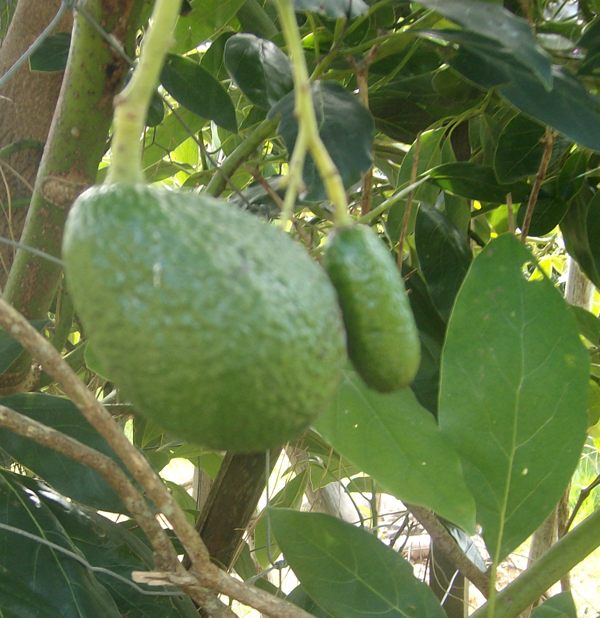
Hass relatively rarely has 'cukes' - small seedless fruit
There is some anecdotal evidence that if you prune trees systematically, not only will it keep the tree size in check, the fruit will mature earlier, and the tree will crop almost every year, albeit more modestly than unpruned Hass trees in their 'on' year.
When to pick
We have several Hass trees. Our biggest - whose planting date is uncertain - is somewhere between 11 and 16 years old (as at 2012). The tree is somewhat shaded, and has some root rot, so its not the most productive. The other 3 trees are about 8 years, 6 and 5 years old, respectively.
The 6 year old had only 1 fruit last year (dec 2010 maturity), but set a fair crop in spring 2011. These will mature in about December 2012 and into early 2013.
The 8 year old had about 30 last season, and has set and held a similar number in the 2011/2012 season.
The interesting thing is that the 8 year old tree set fruit earlier than the oldest and largest tree, and has 'sized' them earlier than the mature tree. And the oldest tree, while larger, tends to have relatively small fruit.
But even smaller size fruit can be acceptable. We have collected smaller immature fruit blown off the tree in late july, and found that they could be ripened. They were mediocre, but they were acceptable. Just.
I know that commercial growers 'up North' pick export fruit based on an acceptable level of 'dry matter' in the flesh, and that this minimum acceptable level (24%) is reached (depending on the seasonal weather) around mid july to very early august in the far North. In some extreme seasons (for example 2005) 24% dry matter was not reached until early september. In the far North, fruit for the very profitable 'early' local market is usually picked in early june, at about 21% dry matter (speeding up of ripening and skin color change is triggered with ethylene gas). Fruit at 21% dry matter are likely to be watery, low in oil, and 'light' in flavor (to put it politely).
In the far North fruit at 24% dry matter have about 16% - 17% by weight of oil. At the peak of dry matter accumulation, around late february, dry matter increases to about 33%, and oil content to about 26%.
Being more southerly, and cooler, you would think northwest Auckland would achieve this 'official' minimum level a bit later than early august.
In the Bay of Plenty, the 'acceptable' dry matter level of 24% is reached between early august and early september (it varies from year to year, possibly depending on temperatures over the fruit swelling period). Maturity, as measured by dry matter, peaks in the Bay of Plenty about mid november. The dry matter at this time is usually in the region of 33%. The oil content hits around 29% or better in january, and increases slightly to around 31% in april (it varies of, course, by year). Note that Hass fruit in the Bay while several weeks slower to reach initial 'acceptable maturity' of 24% dry matter (and roughly 16% oil content), develop a higher oil content than the far North, and even increase it slightly over the summer months into early autumn.
As an experiment, we picked the biggest fruit on the 8 year old tree at the end of june 2011 (from a flower set in spring 2010). The fruit was put in a bag with a ripe apple, as ripe fruit give off ethylene gas. It ripened in about 5 days, but it was perfectly acceptable when it did soften. The flesh was very buttery, with good color, no fibre, a 'light' but good taste, but with a little bitterness. It was acceptable, quite good even, but certainly not 'best'. It was, however, significantly better than the 'winter' Hass fruit we bought from the local supermarket.
This suggests that, at least in the warmer parts of northwest Auckland, in some years, if fruit set in september, some Hass might be able to be 'size-picked' from early july, ethylene ripened with an apple or banana, and be as good or better than 'winter Hass' bought from the local supermarket.
Fruit could almost certainly be size - picked from late august to october in any year, provided you have some decent sized (probably earlier-set) fruit, and so long as you use the 'apple/banana in a bag trick' to trigger ripening.
But in a 'normal' season, fruit probably won't begin to set until very late september or early october. Early to mid october is more likely. These very early set fruit are the ones that 'should' be first to mature in late-winter and early-spring. (In cooler areas it will be later still - october into november). We 'size-picked' some fruit on the 11th of september 2012, and put them with a banana to trigger ripening. Ripeness was measured by a change from a hard green fruit, to a fruit that is more or less black, with some give when lightly squeezed, and with a stem that falls out naturally. Even with a banana, the fruit took until the 21st of September to ripen, a total of 10 days. Admittedly, they were almost as good as summer season Hass - in contrast to the 'light flavored' bronzy-skinned small Hass available at the local supermarket.
This year (2012),the first (undamaged) fruit to show the start of colour change on the tree was noted on September the 20th. It was not the largest fruit on the tree, so size may not always be an indication of maturity.
Some growers in Katikati try to do a pick in september, at the start of flowering. The idea is to allow resources to divert to the flowers, which, after all, are the basis of next seasons fruit.
Hass ripens nicely (without help) from about the end of october onwards here.
January, february, march I consider the 'peak natural ripening' season for us. The 'late set' fruit can be left on the tree until may, which is pretty good (if you can deal to the rats), but the large seed ('stone') can start sprouting a tap root within the fruit at that point. There is also a tendency for some fruit to become a little too highly flavored, with somewhat 'bacony' tasting 'rank' flesh.
Home grown fruit with a rot patch on the skin are not necessarily badly rotten - unlike supermarket fruit.
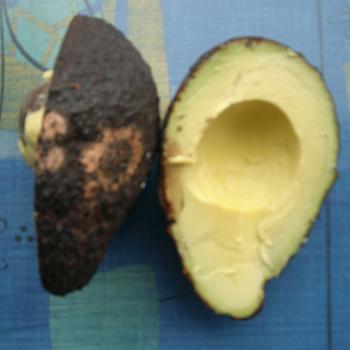
The above fruit has obvious and extensive pink fungal rot on the skin (left). We were going to just throw it out, but on cutting it, it was clear that the rot was both localised and limited (right). In fact, the fruit was perfectly ripe, and was one of the very best Hass fruits I have ever tasted.
Rots in avocado are certainly a problem in New Zealand's slightly 'damp' climate. Varieties vary in their susceptibility to rots, with Reed having very little susceptibility to fuerte being quite susceptible. Hass fruit are also susceptible, but because the skin is black, you can't see the initial rot spots!
Commercially, green fruit picked for market look very good, but unless they have been copper sprayed regularly over the growing season ,almost half will develop rots (a minimum of 8 sprays are recommend - if less than 8 are applied, rots are even worse than if no copper is applied at all). After-harvest rots were a severe problem in the 1990's, to the point of jeopardizing exports. Since then, copper spraying programmes have been more rigorous, bringing the problem down to a (relatively) low level. In addition, it was found that the calcium and magnesium content of the fruit had to be high relative to the potassium content if fruit were to resist storage rot. Unsurprisingly, dense canopies also resulted in greater incidence of rots.
In the home garden situation, so long as the trees receive a bit of dolomite (calcium plus magnesium) from time to time, receive regular small doses of NPK fertiliser in the growing season, a good woody or coarse bark mulch is applied and the trees are kept open and airy, rots are not usually a problem - especially as the fruit is not held in storage, just picked and bench-ripened in the kitchen. If the fruit are scarred by rats or possums, then localised rots are almost certain, but these can be cut out.
Winter Hass
In some years, flowering is triggered in some Hass avocado trees in late autumn, instead of spring. The reason is a mystery. Our youngest Hass tree commenced panicle expansion at 7th of may 2012, even although it has a good crop of young fruit to carry over the winter for late spring/summer maturity. It flowered right throughout winter. A tree only 10 metres away shows no sign of autumn flowers.
Any fruit that sets this may from this 'out of season' flowering should reach maturity from about june/july 2013 onward. Whether the tree flowers again in spring 2012 (thus flowering twice in the same year) remains to be seen. I doubt it, as it is already carrying a good crop on a small tree, so it would normally have an 'off' year next year anyway. However, it will be maturing 'winter' fruit in what would normally be an 'off' year. How this disruption affects the spring 2014 flowering will be interesting to see. (Note; as at august 2012, it appears none of the flowers set. There is very little insect activity over winter, so this may be a factor, or the exceptionally rainy winter in 2012 may be relevant. In autumn 2013 it had a small amount of autumn flower, and 6 fruit set and matured in late may/early june 2014 - see below.)
In june 2011, local supermarkets were offering avocado labelled 'Hass' which looked nothing like Hass at all. Take a look at these photos:
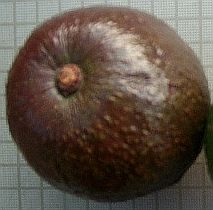
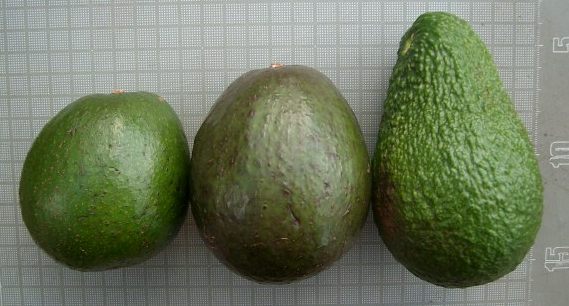
winter Hass winter Hass (two fruit on the left) compared to immature normal Hass (right)
These commercial winter Hass have little or no neck, they have much reduced pebbling on the skin - almost absent in some cases - and the skin is slightly 'pleated' at the stem end. The fruit we bought from the supermarket were very mediocre. While just 'acceptable', they lacked flavor and oiliness. As noted above, an immature, size-picked Helensville Hass was better than these.
That said, I suspect these fruit have been picked a little early to capitalize on the june 'gap month', prior to size-picked far North fruit coming onto the market. They may well be 12 months old, but might have been better left until august.
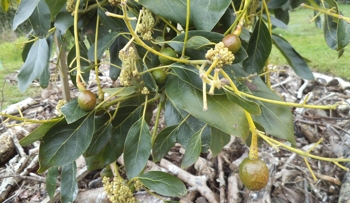
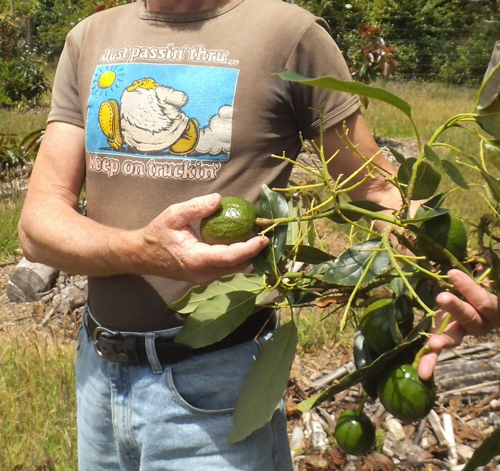 We
have a tree that has had an autumn 'off season' set. At august they
were already large marble size, and at the same time normal spring
flower panicles developed (left hand picture).
We
have a tree that has had an autumn 'off season' set. At august they
were already large marble size, and at the same time normal spring
flower panicles developed (left hand picture).
At december 19th 2013 the 'loco' fruit are very round, shiny, and lack the typical Hass 'bumps'. These fruit are already nearly tennis-ball size. I expect that at this rate they will be mature in late june or july.
The 'normal' spring-set fruit on other Hass trees are only pea to acorn size at this time. Interestingly, although a number of fruitlets initially set from the spring flowering on this 'off season' tree, all of them dropped off.
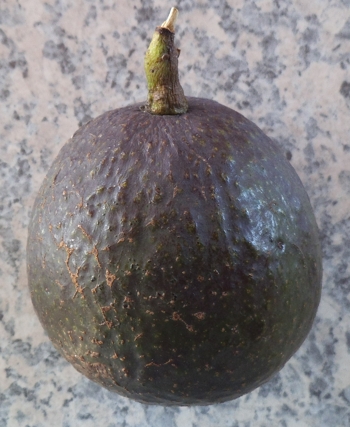
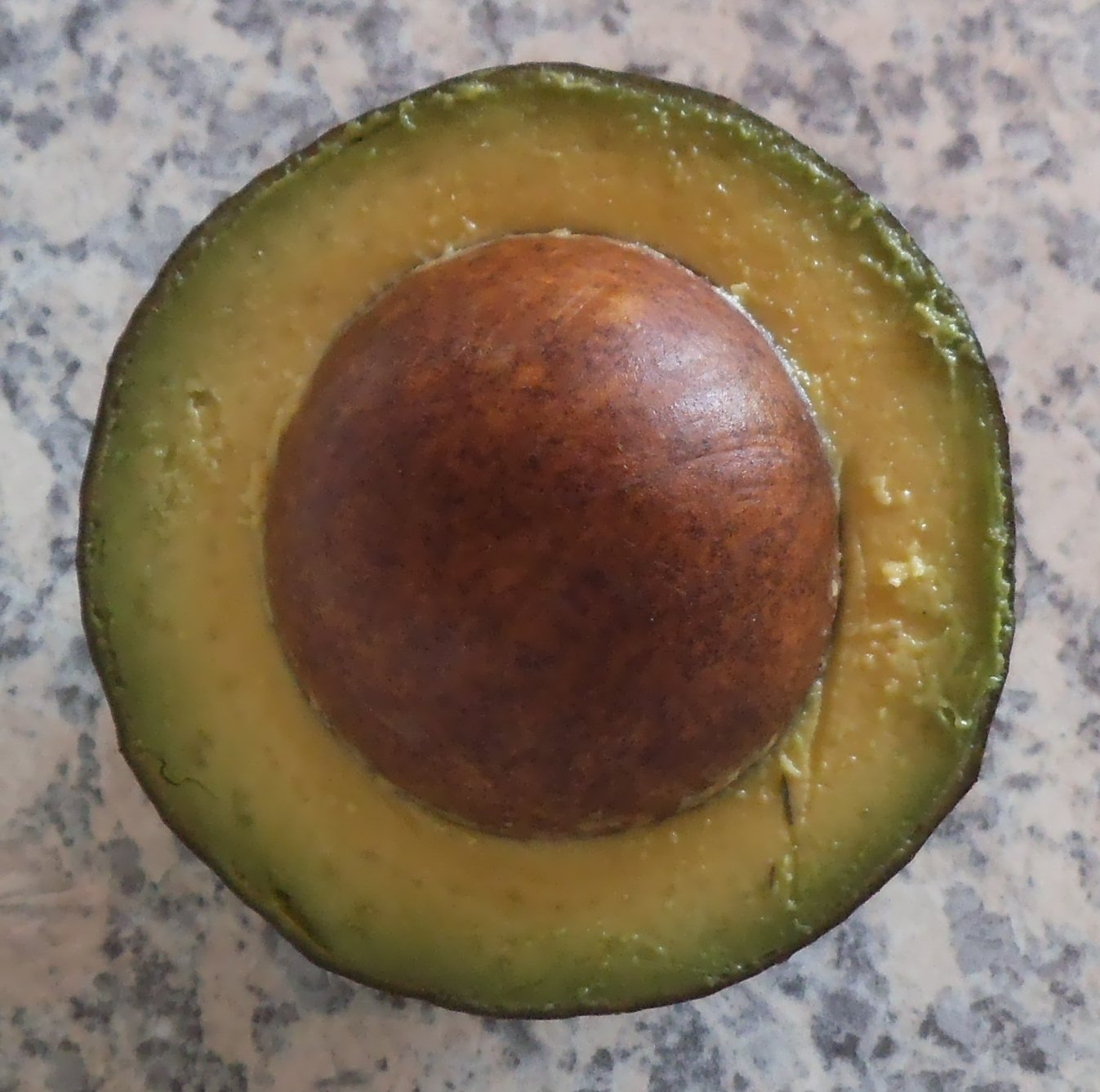 By may
2014 these fruit had become dull, a sure sign of maturity in avocados.
We picked two fruit about 18th of may. By the 26h of may the fruit had
turned from very dull dark green to very dull dark green overlaid with
sparse purple black. The fruit were just off round, and had a small
amount of shallow furrowing in the northern hemisphere of the fruit.
One felt as if it had a little 'give'. Cutting the fruit made it clear
the flesh was still a little firm and probably not fully ripe.
By may
2014 these fruit had become dull, a sure sign of maturity in avocados.
We picked two fruit about 18th of may. By the 26h of may the fruit had
turned from very dull dark green to very dull dark green overlaid with
sparse purple black. The fruit were just off round, and had a small
amount of shallow furrowing in the northern hemisphere of the fruit.
One felt as if it had a little 'give'. Cutting the fruit made it clear
the flesh was still a little firm and probably not fully ripe.
The seed inside was enormous, and is round, rather than the more typical slightly oval shape of a Hass seed. The flesh color was good, a nice yellow, with a bright green zone immediately under the skin and extending about a third the way into the rather thin zone of flesh. Fibres were visible in the flesh, but they were fairly translucent, and barely noticeable. They were in no way noticeable when eating the fruit. The skin was thin, and peeled exceptionally easily, coming off the fruit cleanly and without effort.
The flesh had a low moisture content, and seemed oily and fully flavored, if perhaps somewhat 'dry' to the mouth feel. There were no off flavors, no rots. The overall eating quality was very good. This points to 'off bloom' Hass mature enough to pick from late may onwards. It also suggests that the supermarket fruit in june 2011 had picked early in may and ethylene ripened, explaining their immaturity and inferior quality.
If you have corrections, observations, or comments, feel free to drop a line to:
avocado [and next insert the symbol "@"] lauriemeadows "dot" info. Apologies in advance, I don't check email very often, so acknowledgement may be a wee while coming.
Hass is the best variety by far for the home gardener. It will set fruit without a pollinator, it fruits fairly reliably. Fruit can be available on the tree for around 6 months of the year. Hass can fall into a pattern of an 'on' year when it has lots of fruit, followed by an 'off' year when it has very few fruit, i.e., an alternate bearing pattern. And of course, it has outstanding flavor, no or few fibers in the flesh, the 'stone' is small, and the flesh doesn't stick to the skin. The tree can grow quite large, but it can be controlled with systematic and ruthless pruning. This also helps to moderate Hass's tendency to have a huge crop one year and nothing the next.

Hass relatively rarely has 'cukes' - small seedless fruit
There is some anecdotal evidence that if you prune trees systematically, not only will it keep the tree size in check, the fruit will mature earlier, and the tree will crop almost every year, albeit more modestly than unpruned Hass trees in their 'on' year.
When to pick
We have several Hass trees. Our biggest - whose planting date is uncertain - is somewhere between 11 and 16 years old (as at 2012). The tree is somewhat shaded, and has some root rot, so its not the most productive. The other 3 trees are about 8 years, 6 and 5 years old, respectively.
The 6 year old had only 1 fruit last year (dec 2010 maturity), but set a fair crop in spring 2011. These will mature in about December 2012 and into early 2013.
The 8 year old had about 30 last season, and has set and held a similar number in the 2011/2012 season.
The interesting thing is that the 8 year old tree set fruit earlier than the oldest and largest tree, and has 'sized' them earlier than the mature tree. And the oldest tree, while larger, tends to have relatively small fruit.
But even smaller size fruit can be acceptable. We have collected smaller immature fruit blown off the tree in late july, and found that they could be ripened. They were mediocre, but they were acceptable. Just.
I know that commercial growers 'up North' pick export fruit based on an acceptable level of 'dry matter' in the flesh, and that this minimum acceptable level (24%) is reached (depending on the seasonal weather) around mid july to very early august in the far North. In some extreme seasons (for example 2005) 24% dry matter was not reached until early september. In the far North, fruit for the very profitable 'early' local market is usually picked in early june, at about 21% dry matter (speeding up of ripening and skin color change is triggered with ethylene gas). Fruit at 21% dry matter are likely to be watery, low in oil, and 'light' in flavor (to put it politely).
In the far North fruit at 24% dry matter have about 16% - 17% by weight of oil. At the peak of dry matter accumulation, around late february, dry matter increases to about 33%, and oil content to about 26%.
Being more southerly, and cooler, you would think northwest Auckland would achieve this 'official' minimum level a bit later than early august.
In the Bay of Plenty, the 'acceptable' dry matter level of 24% is reached between early august and early september (it varies from year to year, possibly depending on temperatures over the fruit swelling period). Maturity, as measured by dry matter, peaks in the Bay of Plenty about mid november. The dry matter at this time is usually in the region of 33%. The oil content hits around 29% or better in january, and increases slightly to around 31% in april (it varies of, course, by year). Note that Hass fruit in the Bay while several weeks slower to reach initial 'acceptable maturity' of 24% dry matter (and roughly 16% oil content), develop a higher oil content than the far North, and even increase it slightly over the summer months into early autumn.
As an experiment, we picked the biggest fruit on the 8 year old tree at the end of june 2011 (from a flower set in spring 2010). The fruit was put in a bag with a ripe apple, as ripe fruit give off ethylene gas. It ripened in about 5 days, but it was perfectly acceptable when it did soften. The flesh was very buttery, with good color, no fibre, a 'light' but good taste, but with a little bitterness. It was acceptable, quite good even, but certainly not 'best'. It was, however, significantly better than the 'winter' Hass fruit we bought from the local supermarket.
This suggests that, at least in the warmer parts of northwest Auckland, in some years, if fruit set in september, some Hass might be able to be 'size-picked' from early july, ethylene ripened with an apple or banana, and be as good or better than 'winter Hass' bought from the local supermarket.
Fruit could almost certainly be size - picked from late august to october in any year, provided you have some decent sized (probably earlier-set) fruit, and so long as you use the 'apple/banana in a bag trick' to trigger ripening.
But in a 'normal' season, fruit probably won't begin to set until very late september or early october. Early to mid october is more likely. These very early set fruit are the ones that 'should' be first to mature in late-winter and early-spring. (In cooler areas it will be later still - october into november). We 'size-picked' some fruit on the 11th of september 2012, and put them with a banana to trigger ripening. Ripeness was measured by a change from a hard green fruit, to a fruit that is more or less black, with some give when lightly squeezed, and with a stem that falls out naturally. Even with a banana, the fruit took until the 21st of September to ripen, a total of 10 days. Admittedly, they were almost as good as summer season Hass - in contrast to the 'light flavored' bronzy-skinned small Hass available at the local supermarket.
This year (2012),the first (undamaged) fruit to show the start of colour change on the tree was noted on September the 20th. It was not the largest fruit on the tree, so size may not always be an indication of maturity.
Some growers in Katikati try to do a pick in september, at the start of flowering. The idea is to allow resources to divert to the flowers, which, after all, are the basis of next seasons fruit.
Hass ripens nicely (without help) from about the end of october onwards here.
January, february, march I consider the 'peak natural ripening' season for us. The 'late set' fruit can be left on the tree until may, which is pretty good (if you can deal to the rats), but the large seed ('stone') can start sprouting a tap root within the fruit at that point. There is also a tendency for some fruit to become a little too highly flavored, with somewhat 'bacony' tasting 'rank' flesh.
Home grown fruit with a rot patch on the skin are not necessarily badly rotten - unlike supermarket fruit.

The above fruit has obvious and extensive pink fungal rot on the skin (left). We were going to just throw it out, but on cutting it, it was clear that the rot was both localised and limited (right). In fact, the fruit was perfectly ripe, and was one of the very best Hass fruits I have ever tasted.
Rots in avocado are certainly a problem in New Zealand's slightly 'damp' climate. Varieties vary in their susceptibility to rots, with Reed having very little susceptibility to fuerte being quite susceptible. Hass fruit are also susceptible, but because the skin is black, you can't see the initial rot spots!
Commercially, green fruit picked for market look very good, but unless they have been copper sprayed regularly over the growing season ,almost half will develop rots (a minimum of 8 sprays are recommend - if less than 8 are applied, rots are even worse than if no copper is applied at all). After-harvest rots were a severe problem in the 1990's, to the point of jeopardizing exports. Since then, copper spraying programmes have been more rigorous, bringing the problem down to a (relatively) low level. In addition, it was found that the calcium and magnesium content of the fruit had to be high relative to the potassium content if fruit were to resist storage rot. Unsurprisingly, dense canopies also resulted in greater incidence of rots.
In the home garden situation, so long as the trees receive a bit of dolomite (calcium plus magnesium) from time to time, receive regular small doses of NPK fertiliser in the growing season, a good woody or coarse bark mulch is applied and the trees are kept open and airy, rots are not usually a problem - especially as the fruit is not held in storage, just picked and bench-ripened in the kitchen. If the fruit are scarred by rats or possums, then localised rots are almost certain, but these can be cut out.
Winter Hass
In some years, flowering is triggered in some Hass avocado trees in late autumn, instead of spring. The reason is a mystery. Our youngest Hass tree commenced panicle expansion at 7th of may 2012, even although it has a good crop of young fruit to carry over the winter for late spring/summer maturity. It flowered right throughout winter. A tree only 10 metres away shows no sign of autumn flowers.
Any fruit that sets this may from this 'out of season' flowering should reach maturity from about june/july 2013 onward. Whether the tree flowers again in spring 2012 (thus flowering twice in the same year) remains to be seen. I doubt it, as it is already carrying a good crop on a small tree, so it would normally have an 'off' year next year anyway. However, it will be maturing 'winter' fruit in what would normally be an 'off' year. How this disruption affects the spring 2014 flowering will be interesting to see. (Note; as at august 2012, it appears none of the flowers set. There is very little insect activity over winter, so this may be a factor, or the exceptionally rainy winter in 2012 may be relevant. In autumn 2013 it had a small amount of autumn flower, and 6 fruit set and matured in late may/early june 2014 - see below.)
In june 2011, local supermarkets were offering avocado labelled 'Hass' which looked nothing like Hass at all. Take a look at these photos:


winter Hass winter Hass (two fruit on the left) compared to immature normal Hass (right)
These commercial winter Hass have little or no neck, they have much reduced pebbling on the skin - almost absent in some cases - and the skin is slightly 'pleated' at the stem end. The fruit we bought from the supermarket were very mediocre. While just 'acceptable', they lacked flavor and oiliness. As noted above, an immature, size-picked Helensville Hass was better than these.
That said, I suspect these fruit have been picked a little early to capitalize on the june 'gap month', prior to size-picked far North fruit coming onto the market. They may well be 12 months old, but might have been better left until august.

 We
have a tree that has had an autumn 'off season' set. At august they
were already large marble size, and at the same time normal spring
flower panicles developed (left hand picture).
We
have a tree that has had an autumn 'off season' set. At august they
were already large marble size, and at the same time normal spring
flower panicles developed (left hand picture). At december 19th 2013 the 'loco' fruit are very round, shiny, and lack the typical Hass 'bumps'. These fruit are already nearly tennis-ball size. I expect that at this rate they will be mature in late june or july.
The 'normal' spring-set fruit on other Hass trees are only pea to acorn size at this time. Interestingly, although a number of fruitlets initially set from the spring flowering on this 'off season' tree, all of them dropped off.

 By may
2014 these fruit had become dull, a sure sign of maturity in avocados.
We picked two fruit about 18th of may. By the 26h of may the fruit had
turned from very dull dark green to very dull dark green overlaid with
sparse purple black. The fruit were just off round, and had a small
amount of shallow furrowing in the northern hemisphere of the fruit.
One felt as if it had a little 'give'. Cutting the fruit made it clear
the flesh was still a little firm and probably not fully ripe.
By may
2014 these fruit had become dull, a sure sign of maturity in avocados.
We picked two fruit about 18th of may. By the 26h of may the fruit had
turned from very dull dark green to very dull dark green overlaid with
sparse purple black. The fruit were just off round, and had a small
amount of shallow furrowing in the northern hemisphere of the fruit.
One felt as if it had a little 'give'. Cutting the fruit made it clear
the flesh was still a little firm and probably not fully ripe. The seed inside was enormous, and is round, rather than the more typical slightly oval shape of a Hass seed. The flesh color was good, a nice yellow, with a bright green zone immediately under the skin and extending about a third the way into the rather thin zone of flesh. Fibres were visible in the flesh, but they were fairly translucent, and barely noticeable. They were in no way noticeable when eating the fruit. The skin was thin, and peeled exceptionally easily, coming off the fruit cleanly and without effort.
The flesh had a low moisture content, and seemed oily and fully flavored, if perhaps somewhat 'dry' to the mouth feel. There were no off flavors, no rots. The overall eating quality was very good. This points to 'off bloom' Hass mature enough to pick from late may onwards. It also suggests that the supermarket fruit in june 2011 had picked early in may and ethylene ripened, explaining their immaturity and inferior quality.
If you have corrections, observations, or comments, feel free to drop a line to:
avocado [and next insert the symbol "@"] lauriemeadows "dot" info. Apologies in advance, I don't check email very often, so acknowledgement may be a wee while coming.
2012, 2013, 2014